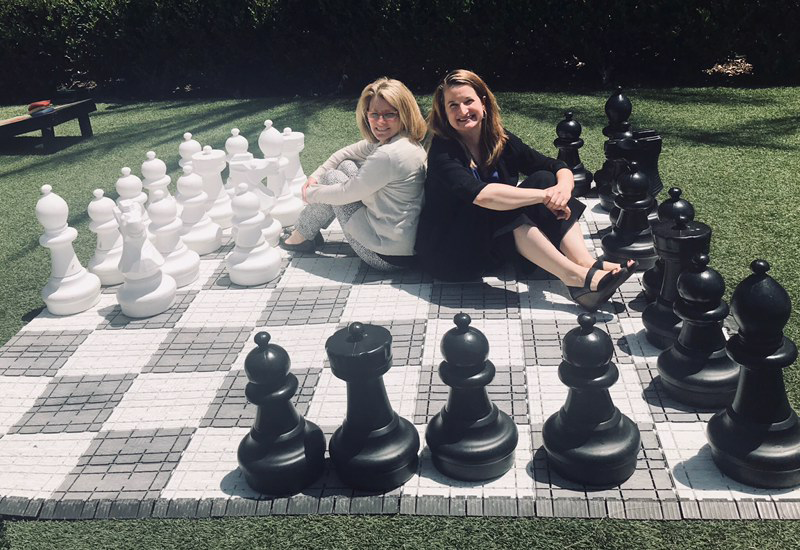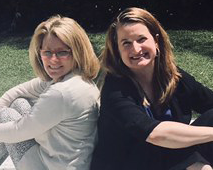We are pleased to share the following contribution, from our partner Catina O’Leary, PhD, Health Literacy Media president and CEO.

Catina O’Leary, PhD, (left) and Amy Waterman, PhD, have partnered to bring kidney transplant education out of the transplant center and into patients’ lives.
The game of chess starts with the opener – a set of moves that, to the untrained eye, might seem mundane and inconsequential. To the expert, though, the opener is an essential strategic step. A well-chosen set of opening moves can ensure victory, while the wrong ones can cost a player the game.
Indeed, any sound strategy – competitive or cooperative – begins with a well-planned set of moves. Identify the challenges, make a plan to address them, and figure out who you need on your team.
A strategic partnership that was built with a goal of developing a new benchmark for kidney transplant education has its roots in an auspicious setting: the White House. Amy D. Waterman, PhD, the founder of Explore Transplant, spoke at the White House Organ Summit in the summer of 2016, part of the Obama administration’s effort to close the gap between people who are in need of a life-saving transplant and the supply of available organs.
A call to action
As a leading transplant psychologist, Waterman knows the importance of effective educational resources for kidney patients and those who are considering living donation. In fact, a cornerstone of the White House effort involved the development of resources to support informed decision making.
“Research shows that patients and their family members and friends who receive education as early as possible are more likely to become waitlisted and receive living donor kidney transplants,” says Waterman, who directs UCLA’s Transplant Research and Education Center.
At the same time, Waterman says she sees the opportunity to provide education for patients and their loved ones as a way to address a different kind of shortage – a shortage of effective and consistent education that is available outside of the context of a transplant centers.
Many patients have significant barriers to visiting a transplant center to learn about their options, and these barriers can be compounded for patients of low socioeconomic status.
This shortage of resources that can meet patients where they are, and the opportunity it presents to get quality, impactful resources out into the world, is where health literacy comes in.
Enter Health Literacy Media (HLM), and its President and CEO Catina O’Leary, who knew Waterman during their time at Washington University in St. Louis. HLM’s experience in developing patient-facing educational materials in a variety of interactive media types was a natural fit.
Getting all the pieces on the board
But HLM is just one member of a broad coalition that answered the call for equity in access to high-quality transplantation for the nearly 700,000 Americans who live with chronic kidney disease. In fact, Waterman and O’Leary presented this year at the Institute for Healthcare Advancement on their best-practice approach to identifying and engaging stakeholders. They describe the roles – and the professionals best suited to fill them – that are necessary for a truly interdisciplinary development process.
- Educational partners: A blue-ribbon panel of researchers and experts to review and vet content for medical and scientific accuracy
- External organizations: Thought leaders from nonprofit, advocacy, foundation, pharma, and governmental organizations to advise on strategies for dissemination, evaluation, and promotion
- Core team: Content creators, designers, health literacy experts, and coordinators to develop new and innovative educational materials and media
- Patients and living donors: Representatives from the resources’ intended audience to provide input and advice
The key is early and consistent involvement for these partners to ensure input and insights are built in to the DNA of the educational resources, and aren’t just on the surface.
A clearinghouse of resources
The team envisioned a strategy to get the right message to the right audience at the right time, through resources that live outside the traditional spaces of health education.
“To have a real impact, patient education has to actually get into the hands of patients,” says O’Leary. “It’s not enough to make something and wait for people to come to you.”
This perspective guided the development of a family of resources that could meet the needs of diverse audiences, particularly those who may have less experience with the healthcare system.
- The KTLC Kidney Transplant Learning Center – delivers high-quality, health-literate education through the United Network for Organ Sharing (UNOS) – one of the most trusted and authoritative voices in the field
- Explore Transplant and Explore Living Donation education – empowering and action-oriented education for patients and families, anchored by compelling video stories from real patients and donors
- Explore Transplant provider training – teaches health professionals in dialysis and nephrology – ideal partners to reach kidney patients in large numbers – to educate patients and families
- My Transplant Coach – an interactive decision aid to deliver tailored transplant education that’s optimized for mobile devices
To Waterman, it’s truly a health equity issue to reach patients who are at the beginning of their transplant journey. “When patients start out smarter,” she says, “they can take advantage of all these new clinical innovations, and I want everyone to have access to them!”
The end game
While the transplant community cannot yet call “checkmate” on the organ shortage, the Explore Transplant team has some notable successes and insights. For one, it’s reaching people: dialysis provider training courses have reached more than 7,500 professionals, while the Explore Transplant website reaches tens of thousands of users annually. But more than this, these resources are making a difference for those who may have been left out in the past. Waterman’s peer-reviewed research indicates that education can make an outsize impact on transplant disparities – when it is designed with patients’ lives in mind.
“We may not yet have enough kidneys to go around, but we can make sure that there’s enough education to go around,” Waterman says.
– Catina O’Leary

